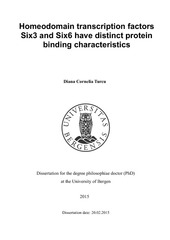| dc.description.abstract | The goal of this study was to characterize Six3 and Six6 proteins interactions and to better understand their functions. The Six class proteins are found in a wide variety of animals ranging from primitive invertebrate species to mammals. They belong to the class of evolutionarily conserved homeodomain-containing transcription factors, which regulate the transcription process of key genes during animal development. Mammals contain 6 Six proteins divided into three groups (Six1/2, Six3/6, and Six4/5) while fish contain more Six proteins due to extra whole genome duplication events occurred in the teleost lineage. The proteins belonging to the Six3/Six6 group are crucial for early embryonic specification of forebrain and eyes and for retinal cell proliferation and neurogenesis. However, mechanistic aspects of their actions and the functional divergence in this group have not been studied well. Six3 proteins have been shown to act in forebrain and eye development both as transcriptional activators and repressors and to function as regulators of cell proliferation through interactions with other proteins such as the cell cycle inhibitor Geminin. Six6 proteins have been shown to be less involved in brain development and the implications of their interaction with Geminin have not been studied to date. In order to achieve the goal of this study, the interactions of human SIX3 and SIX6 proteins to GEMININ were investigated by docking analysis, surface plasmon resonance (SPR), isothermal titration calorimetry (ITC), and bimolecular fluorescence complementation (BiFC). Docking analyses showed a different interphase for the SIX3-GEMININ complex as compared to the SIX6-GEMININ complex. To verify these results, SPR was used. We observed a selective binding of the SIX domain of SIX3 (SIX3SD) relative to the full-length SIX3 protein, implying that SIX3SD is the main structure involved in SIX3 binding to GEMININ. Furthermore, SIX3SD showed a 10-fold higher binding affinity to GEMININ compared with the SIX domain of SIX6 (SIX6SD). ITC measurements of SIX3-GEMININ interaction showed a binding ratio SIX3 to GEMININ of 1:2 and revealed, in addition, that the interaction does not occur through the coiled-coil region of GEMININ. The interaction of full-length SIX3 and SIX6 proteins to GEMININ was confirmed through a strong fluorescence signal by means of BiFC in mammalian cells. Conversely, the BiFC signal was very low for SIX3SD or SIX6SD, implying a lack of interaction of the SIX domains with GEMININ in living cells. The zebrafish Six3 proteins Six3a and Six3b have not been characterized at the protein level although previous studies have shown spatiotemporal differences in mRNA expression patterns. We compared the predicted 3D-structures of Six3a and Six3b and their electrostatic maps and detected differences both in predicted structures and in the charge distributions between these two paralogous. Moreover, electrophoretic mobility shift assay (EMSA) showed that the full-length Six3b protein does not bind to the Six3a DNA recognition sequence. The binding affinity of Six3a and Six3b to Geminin was further measured by SPR. The SPR measurements showed that Six3b has a 3-fold higher affinity for Geminin than Six3a. In addition, the formation of strong heterodimer between Six3a and Six3b was detected in SPR. The BiFC assay in mammalian cells confirmed SPR binding results. Moreover, BiFC revealed that Six3b formed homodimers, whereas Six3a did not. Subcellular localization patterns for these two paralogous Six3 proteins were found to be different. Six3a was localized more to nucleus and nucleoli-like structures, whereas Six3b was primarily found in the cytoplasm, especially in Golgi-like structures. As a concluding remark, the results presented in this study show that, although Six3 and Six6 proteins share very high sequence identities and may assume similar structures, they have different abilities in protein interactions and hence may assume different cellular functions. | en_US |
